Spotlight on science
Remarkable University of Newcastle science innovations
The University of Newcastle is ranked in the top three per cent of universities in the world, with science considered a major research strength. Fourteen areas of science are listed at 'well above world standard' in the 2012 Excellence in Research Australia (ERA) ratings, nine other sciences are listed at above world standard and we are one of only two Australian universities to achieve a '5' star rating of 'well above world standards' in applied mathematics, biochemistry and cell biology.
Leapfrogging extinction
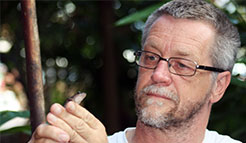
Our amphibian scientists, Professor Michael Mahony, father and son, Dr John Clulow and Simon Clulow, received worldwide attention as part of a national team that resurrected living embryos from an extinct gastric-brooding frog using cloning techniques. The University of Newcastle team, which also included Bianca Lawson, was also the first to successfully cryo-preserve amphibian embryonic cells. These significant breakthroughs will provide an insurance policy for the more than 200 species of frogs currently facing extinction. It also has implications for many other species of fish and amphibians around the world.
Revolutionising home healthcare
Patients and hospitals are set to benefit from a new antibiotic device co-created by University of Newcastle researcher Professor Paul Dastoor that promises to free up hospital beds and dramatically lower healthcare costs. The concept design was drawn on the back of a napkin 10 years ago and is now used in six hospitals. MobiDRIP does not require electrical power, it is lightweight and easy to operate, and allows patients requiring an intravenous drip to recover in their own home. Clinical trials have shown it to be more accurate at supplying antibiotics than computer-based pumps. The potential lies in this product being used not only in hospitals and homes, but in ambulances, the military and even veterinary clinics, as well as remote regions and countries that do not have access to electricity. The long-term opportunity lies in the huge international market for home healthcare, which in the USA alone is more than one billion dollars annually.
More: UoN researchers antibiotic device to improve home healthcare
Fishy business
Every year around the world, more than 7.3 million tonnes of unwanted fish is discarded by fishing vessels. For every kilo of prawns caught there can be up to 20kgs of bycatch. Dr Troy Gaston, from the University of Newcastle has helped develop a self-powered light source that illuminates the area in front of the trawl to address this major environmental and economic efficiency issue. This method has been shown to reduce the number of non-target animalsentering the mouth of the trawl, decreasing bycatch by up to 30 per cent. It has also been shown to increase prawn catch by up to 11 per cent. This new device makes trawling more efficient, improves the quality and value of the yield, lowers bycatch mortality rates, and is sustainable. This is a collaborative project between the University of Newcastle, Australian Maritime College, University of Tasmania and Marine Lighting Technologies.
World's largest mathematical picture – Walking on Pi
Mathematicians have long searched for a tool that would help prove if strings of numbers were truly random or had some sort of higher order structure. Motivated by the desire to show the behaviour of the first billions of digits of Pi in just one picture and visualise large mathematical data sets, University of Newcastle researchers, led by Laureate Professor Jonathan Borwein, produced the largest mathematical picture ever made and placed it on the web. The strikingly beautiful images and more can be found at the Priority Research Centre for Computer-Assisted Research Mathematics and its Applications.
More: About Professor Jonathan Borwein's research
A blood test for asthma
In a study published this year in the American Journal of Respiratory and Critical Care Medicine, a team from the University of Newcastle lead by Professor Peter Gibson used theemerging scientific field of proteomics (the study of proteins)to identify four blood-based biomarkers that when analysedtogether can distinguish between asthma and chronicobstructive pulmonary disease. The two diseases sharecommon symptoms, so are difficult to distinguish, but requiredifferent therapeutic approaches. This finding could lead tothe development of the first blood test for asthma, whichwould be a major diagnostic breakthrough for the estimated 300 million people worldwide suffering from asthma.
More: Joining forces to ease the wheeze
Treating asthma with antibiotics
Professor Peter Gibson from the University of Newcastle is leading a team of researchers undertakingthe world's biggest study into non-eosinophillic asthma. The AMAZES study (Asthma and Macrolides: Azithromycin Efficacy and Safety) will trial an alternative treatment, known as a macrolide antibiotic, for asthma that is not responsive to conventional steroid medication. Steroids treat a particular cell, called an eosinophil, which is thought to provoke inflammation when present in increased levels. But research has established that up to half of adults with asthma symptoms have normal levels of eosinophils and respond poorly to conventional treatment. The five-year, $2.9 million study, is trialling the antibiotic on approximately 400 asthmatics in four cities.
More: Joining forces to ease the wheeze
Indigenous maths and science
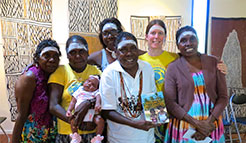 The University of Newcastle's Dr Sarah Wright, together with Yolgnu women from Bawaka in Northeast Arnhem Land and colleagues from Macquarie University, have published a book that features Indigenous understanding of mathematics and science. The book focuses on the patterns, rhythms and relationships that underpin ways of being and belonging at Bawaka. Yolngu mathematics refers to the complex matrix of patterns, relationships, shapes, motions and rhythms of time and space that underpin the ways that Yolngu nourish, and are nourished by, their country. 'Welcome to my Country' is written by Laklak Burarrwanga, Ritjilili Ganambarr, Merrkiyawuy Ganambarr, Banbapuy Ganambarr, Djawundil Maymuru, Sarah Wright, Sandie Suchet-Pearson and Kate Lloyd.
The University of Newcastle's Dr Sarah Wright, together with Yolgnu women from Bawaka in Northeast Arnhem Land and colleagues from Macquarie University, have published a book that features Indigenous understanding of mathematics and science. The book focuses on the patterns, rhythms and relationships that underpin ways of being and belonging at Bawaka. Yolngu mathematics refers to the complex matrix of patterns, relationships, shapes, motions and rhythms of time and space that underpin the ways that Yolngu nourish, and are nourished by, their country. 'Welcome to my Country' is written by Laklak Burarrwanga, Ritjilili Ganambarr, Merrkiyawuy Ganambarr, Banbapuy Ganambarr, Djawundil Maymuru, Sarah Wright, Sandie Suchet-Pearson and Kate Lloyd.
More: About Dr Sarah Wright's research
Gene mining
As one of only two research centres in Australia, the Priority Research Centre for Bioinformatics, Biomarker Discovery and Information-Based Medicine has developed a method-based on information theory to track the progression of cancer and Alzheimer's Disease in the brain. The Centre, co-directed by geneticist Professor Rodney Scott and computer scientist Professor Pablo Moscato, directly links bioinformatics with clinical research practice and is at the forefront of the emerging field of developing patient-tailored treatments based on genetic analysis.
The Centre's researchers are pushing the boundaries of molecular interrogation techniques, looking for ways to provide more sophisticated information, including a forensic analysis of data that seeks to explain, rather than dismiss, even minor statistical anomalies.
More: About Professor Pablo Moscato
Helping to lead fight against STDs
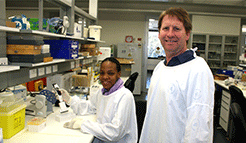 University of Newcastle researcher Professor Phil Hansbro and his team, including Jay Horvat and Jemma Mayall, has contributed to the discovery of the Interferon epsilon (IFNe) protein in the female reproductive tract that protects against sexually transmitted diseases (STDs) such as chlamydia and herpes simplex virus. An estimated 450 million people worldwide are newly infected with STDs each year. The discovery could have clinical potential to boost protective immunity and to determine which women may be more or less susceptible to disease such as STIs. Researchers are currently investigating whether this work can be used to treat STIs and whether it can be applied to other diseases such as cancer, endometriosis and pelvic inflammatory disease.
University of Newcastle researcher Professor Phil Hansbro and his team, including Jay Horvat and Jemma Mayall, has contributed to the discovery of the Interferon epsilon (IFNe) protein in the female reproductive tract that protects against sexually transmitted diseases (STDs) such as chlamydia and herpes simplex virus. An estimated 450 million people worldwide are newly infected with STDs each year. The discovery could have clinical potential to boost protective immunity and to determine which women may be more or less susceptible to disease such as STIs. Researchers are currently investigating whether this work can be used to treat STIs and whether it can be applied to other diseases such as cancer, endometriosis and pelvic inflammatory disease.
Saving breast cancer patients
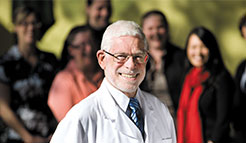 The University of Newcastle and the Hunter Medical Research Institute (HMRI) was involved in early global breast cancer trials that established the benefits of chemotherapy and hormone treatments, in particular the drug tamoxifen, in post-operative care. The breakthrough is thought to have saved many thousands, if not millions, of breast cancer patients around the world. The lead researcher, Professor John Forbes, is a decorated oncologist and academic who has been named one of the top 10 researchers in the world, regardless of field.
The University of Newcastle and the Hunter Medical Research Institute (HMRI) was involved in early global breast cancer trials that established the benefits of chemotherapy and hormone treatments, in particular the drug tamoxifen, in post-operative care. The breakthrough is thought to have saved many thousands, if not millions, of breast cancer patients around the world. The lead researcher, Professor John Forbes, is a decorated oncologist and academic who has been named one of the top 10 researchers in the world, regardless of field.
More: Man on a mission
Stroke of genius
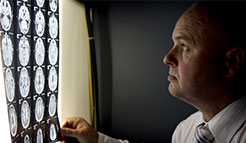 Our stroke research team, led by world-renowned researcher, Conjoint Professor Chris Levi, has driven breakthroughs in treatments and developed protocols that have vastly improved the outcomes for stroke sufferers. For the right candidate, the treatment is dramatic – it is a cure for stroke. The groundbreaking model of care combines the use of thrombolytic therapy, or 'clotbusting' drugs, with CT imaging of the brain. In suitable patients the clot-busting drug tPA can dissolve the blockage in their brain that has caused the stroke and prevent further damage. When successful, the treatment has great benefits for the patient – it can mean the difference between living dependently or independently. From a community perspective, it is also highly beneficial. With an estimated cost of up to $500,000 for a stroke patient with high care needs, the effective use of tPA is significantly reducing pressure on the health care budget.
Our stroke research team, led by world-renowned researcher, Conjoint Professor Chris Levi, has driven breakthroughs in treatments and developed protocols that have vastly improved the outcomes for stroke sufferers. For the right candidate, the treatment is dramatic – it is a cure for stroke. The groundbreaking model of care combines the use of thrombolytic therapy, or 'clotbusting' drugs, with CT imaging of the brain. In suitable patients the clot-busting drug tPA can dissolve the blockage in their brain that has caused the stroke and prevent further damage. When successful, the treatment has great benefits for the patient – it can mean the difference between living dependently or independently. From a community perspective, it is also highly beneficial. With an estimated cost of up to $500,000 for a stroke patient with high care needs, the effective use of tPA is significantly reducing pressure on the health care budget.
More: Agent of change
Painting the world solar
The idea of a photovoltaic paint seemed like pure science fiction when Professor Paul Dastoor began investigating alternative solar energy technology 15 years ago. Yet the physicist is now on the threshold of commercial-scale production of an energy system based on solar cells that can be printed, and ultimately painted, onto surfaces.Solar paint is an environmentally friendly solar cell technology with the potential to allow every household in Australia to generate their own electricity, affordably and sustainably. The invention involves the development of a completely printable organic solar cell based on semiconducting polymer nanoparticles dispersed in water. Essentially these tiny particles in suspension are a water-based paint, which can be printed or coated over large areas.
More: Something new under the sun
Australia's largest export in the past 20 years
The University of Newcastle, based in the largest coal mining region in Australia, has been working for the past 20 years to develop innovations in the field of mining operations. One such innovation is the froth flotation process, which is now relied upon by mining operations globally to separate valuable minerals from host rock. Improvements in this process lead directly to more efficient and cost effective productions as well as increased profit. Another mining innovation, the Jameson Cell, is a radical new flotation device. The Cell was developed at the University of Newcastle in conjunction with mining industry partners. The Jameson cell is now implemented in over 25 countries world-wide including Australia, USA, South Africa, China and Mexico. From 1990-2011, the cumulative total value of export coal recovered by the Jameson Cell in NSW and Queensland was AU$22.1 billion. In 2011 alone it was AU$4.3 billion.
Read more: The Jameson cell for flotation of minerals and coal.
Cardiology riddle solved in a 3D heartbeat
Using sophisticated computer modelling, University of Newcastle researcher, Associate Professor Derek Laver, helped find the missing piece to a 20-year cardiology puzzle – working out precisely how the heart regulates its beat. Associate Professor Laver, in collaboration with researchers from the University of Bristol, investigated the factors that trigger and also terminate the microscopic releases of calcium which regulate the heart muscle. The research will help identify a better way to improve understanding of heart failure, with evidence suggesting that the calcium release mechanism becomes faulty. The next step is to introduce the known effects of anti-arrhythmic drugs to the 3D modelling to explain exactly why they work.
Read more: Cardiology riddle solved in 3D heartbeat
Sustainable ecosystem restoration
The Centre for Sustainable Ecosystem Restoration (CSER) is internationally recognised for its research into the reconstruction of functional and sustainable native ecosystems on degraded landscapes, such as disused agricultural land and at mine sites. Led by the Centre's three principal academics, Director Mike Cole, Dr Yvonne Bussbaumer and Dr Carmen Castor, CSER's focus is on how to reconstruct ecosystem function through the promotion of soil function and the re-establishment of habitat. Research on this topic has been presented at national and international conferences and has been recognised at an international level through the listing of the Model Site at the "Ravensworth State Forest Vegetation Complex" on the Global Restoration Network of the Society for Ecosystem Restoration, International as a highly commended site. This is of major significance for the Hunter Region where over three quarters of the land has experienced vegetation decline.
Read more: Centre for Sustainable Ecosystem Restoration
Stressed to the joints
Melissa Harris' recent PhD work has provided the most convincing evidence to date regarding the identification of perceived stress as a risk factor for arthritis onset. Notably, perceived stress was found to confer a greater risk of arthritis onset than obesity. The study focused on women who had completed the Australian Longitudinal Study on Women's Health. The Annual of Behavioural Medicine said Harris's study "exemplified the importance of stress in the genesis of arthritis - a finding that has the potential for enlightening the field of rheumatology and the care of patients who may be at risk for arthritis-related illnesses".
More: About Melissa Harris' research
Innovation gone viral
Every Monday morning in winter, more than 14,000 Australians log onto Flutracking.net and report on flu symptoms, visits to doctors and lab test results for influenza. Dr Craig Dalton, the Director of Flutracking.net, said the project has received international recognition and developed into an international collaboration in what is now known as "participatory disease surveillance". Google Flu Trends and the Skoll Foundation for Global Threats drew on the University's expertise to launch "Flu Near You" a new system that now tracks influenza across the USA. It is also used in national, European and North American online global surveillance systems. It has been able to demonstrate that the 2009 pandemic influenza strain did not have a higher attack in the community than many other years - this was the sort of evidence that was able to support the easing of pandemic quarantine and other restrictions.
More: Dr Craig Dalton's research
Minimising the energy required to transport the world's raw materials
In the field of applied science, researchers at the University of Newcastle have joined with industry partners to develop a world-first facility to test and improve the energy consumption of the world's longest belt conveyors. The test facility located at the Newcastle Institute for Energy and Resources (NIER), is developing the next generation of low energy conveyor belting. With belt conveyors becoming longer and faster, all around the world belt conveyor systems are rapidly replacing fleets of haul trucks for long distance bulk material transportation. Our researchers at TUNRA are currently undertaking testing of components to build a 26kmconveyer belt in South Africa. They will use the NIER test facility to develop a recommended approach for determining the energy consumption of long distance belt conveyors; the information will be published in a revised American Conveyor Equipment Manufacturers Association (CEMA) handbook for conveyor design to be issued later this year.
More: About Bulk Solids research
Addicted to food
Emerging evidence suggests that obesity may be a form of substance dependence, sharing similar clinical characteristics to those associated with the diagnostic criteria for substance dependence. To investigate this, researchers PhD student, Kirrily Pursey, Dr Tracy Burrows, Professor Clare Collins and Associate Professor Peter Stanwell from the University of Newcastle launched an online survey to determine whether food addiction exists in Australia, and whether it is associated with certain foods, gender or body measures. A total of 669 predominantly female respondents ranging from 18-35 years participated in the survey. Surprisingly, 95.8 per cent of respondents displayed at least one characteristic associated with food addiction and 19.7 per cent displayed all seven characteristics. Researchers are currently validating these food addiction scores using functional medical resonance imaging (fMRI) scans of the brain, which show areas of the brain 'lighting' up in response to cognitive tasks such as responses to specific foods. The research will help determine whether an addiction to food could be an additional contributing factor to obesity and could help to explain why some people find it more difficult to lose and maintain weight in traditional weight loss therapies focusing on diet and exercise.
Contact
- Kate Carragher
- Phone: +612 4921 5868
Related news
- Healthy recognition: Dietitian earns prestigious Australian science honour
- Nine Newcastle teams secure $5.4m in ARC Discovery grants to unearth new knowledge
- Heart of the problem is short lifespan of disease prevention programs
- Community collaboration takes flight in bird opera workshop
- Grand Challenge winners share in $30
The University of Newcastle acknowledges the traditional custodians of the lands within our footprint areas: Awabakal, Darkinjung, Biripai, Worimi, Wonnarua, and Eora Nations. We also pay respect to the wisdom of our Elders past and present.